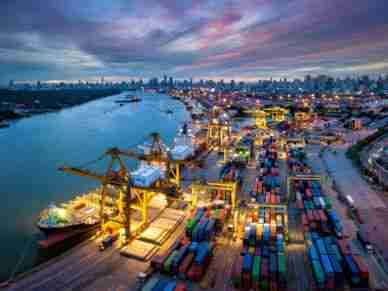
When optimizing freight logistics, intermodal transport serves as a powerful solution for reducing costs and minimizing environmental impact. Integrating multiple transportation modes, such as rail and truck, allows businesses to achieve greater efficiency and lower expenses. The approach supports environmental sustainability through reduced fuel consumption and emissions. This post explores how intermodal freight transport balances economic and ecological benefits.
Understanding Intermodal Freight Transport
Intermodal freight transport involves the transfer of cargo between different modes of transportation, such as rail, road, and water, without handling or reloading the goods. This efficient system optimizes logistics and reduces costs.
Key components of intermodal freight include:
- Intermodal containers: Standardized containers that can be easily transferred between different modes of transport
- Intermodal terminals: Specialized facilities equipped to handle and transfer intermodal containers efficiently
- Intermodal transport operators: Companies that coordinate and manage the entire intermodal transportation process, which can include a rail operator, ocean shipping forwarder, and road hauler, among others
Intermodal freight offers several advantages over traditional transportation methods, including reduced handling costs, improved efficiency, and enhanced security.
Cost Reduction Benefits of Intermodal Freight
Intermodal freight transport offers several cost-reduction benefits through its efficient use of multiple transportation modes.
Optimized Transportation Routes
Intermodal freight reduces costs through optimized transportation routes. Combining rail, road, and sea transport leverages the strengths of each mode. For example, rail provides a cost-effective solution for long-haul trips, while road transport offers flexibility for last-mile delivery. This combined approach cuts overall shipping expenses.
Lower Fuel Expenses
Utilizing rail for long distances significantly lowers fuel costs. Rail transport is more fuel-efficient for bulk cargo, decreasing the cost per ton-mile. The integration of road transport allows for flexible, cost-efficient solutions that complement the fuel savings achieved through rail.
Reduced Handling Costs
Intermodal systems streamline handling with standardized containers used across various transport modes. This reduces the need for multiple loadings and minimizes labor costs and the risk of cargo damage. Fewer handling operations contribute to overall cost savings.
Enhanced Asset Utilization
Efficient use of containers and vehicles across different transport modes improves asset utilization. Maximizing the productivity of these assets leads to reduced costs and higher profitability for transport operators.
Intermodal freight offers a strategic advantage in cost reduction, combining the efficiencies of different transportation modes to lower overall expenses.
Environmental Impact Reduction with Intermodal Freight
Apart from cost savings, intermodal freight transport offers notable environmental benefits.
Lower Greenhouse Gas Emissions
Intermodal transport significantly cuts greenhouse gas emissions. Rail transport, with its high energy efficiency, handles most long-distance cargo. It emits fewer greenhouse gases compared to road transport. Integrating rail with road transport optimizes fuel usage, leading to further reductions in overall emissions.
Decreased Road Congestion
Using rail and sea routes for long-haul shipping eases road congestion. With fewer trucks on the road, traffic congestion decreases, resulting in lower emissions from idling vehicles. This reduction in congestion improves air quality and lowers the carbon footprint associated with road transport.
Efficient Fuel Use
Rail and ocean shipping provides superior fuel efficiency compared to road transport. Rail systems move large volumes of cargo with less fuel, while ocean shipping forwarders offer energy-efficient solutions for international freight. Efficient fuel use across these modes minimizes the environmental impact of freight operations.
Intermodal freight transport supports environmental sustainability through its combination of efficient transport modes, reduced road congestion, and lower greenhouse gas emissions.
Factors Affecting Intermodal Freight Cost and Efficiency
Several factors play a role in determining the cost and efficiency of intermodal freight transport. The distance covered, for example, impacts fuel consumption and transit time, influencing overall expenses. The choice of transportation modes also matters. Rail, truck, and ocean shipping forwarders each have unique costs and advantages, depending on the cargo and destination.
Additionally, the coordination between different carriers and modes affects efficiency. Efficient transfers and handling reduce delays and minimize costs. Infrastructure quality such as the availability of intermodal terminals directly influences the smooth transition of goods between modes.
Lastly, technological integration in tracking and managing shipments ensures timely delivery and cost-effective operations. Efficient use of technology enhances communication between all parties involved, leading to streamlined processes and reduced operational costs.
Careful consideration of these factors leads to more effective and economical intermodal freight transport.
Challenges and Considerations
Intermodal freight transport offers cost and environmental benefits, but it also presents challenges that must be managed. Coordinating multiple transportation modes requires meticulous planning and synchronization. Delays at transfer points between rail, road, and ocean shipping can disrupt schedules, leading to increased costs and inefficiencies.
Infrastructure limitations also pose significant challenges. Not all regions have well-developed intermodal facilities, which may limit access to efficient transport routes. Additionally, handling and transferring goods between different modes risk potential damage or loss, necessitating careful handling and secure packaging.
Finally, regulatory differences between regions and countries add complexity. Compliance with varying laws and standards requires thorough knowledge and careful planning. Despite these challenges, with proper management and strategic planning, the benefits of intermodal freight transport outweigh the potential drawbacks, making it a viable and efficient option for many businesses.
Future Trends and Opportunities in Intermodal Freight
Intermodal freight transport is poised for significant growth, driven by advancements in technology and shifting market demands. Automation and digital tools are streamlining operations, improving efficiency through real-time data tracking and predictive maintenance. These innovations help reduce operational costs and enhance reliability, making intermodal transport a preferred choice for many businesses.
Sustainability efforts are also influencing the industry. Companies are increasingly adopting eco-friendly practices, including the use of electric vehicles and alternative fuels. These efforts align with global initiatives to reduce carbon emissions, creating opportunities for businesses offering sustainable transport solutions.
Additionally, the rise of e-commerce and global trade is expected to boost demand for intermodal freight services. Companies that invest in infrastructure and develop strategic partnerships stand to benefit from these expanding markets. Emerging economies, in particular, present significant growth opportunities, offering a fertile ground for businesses ready to adapt to the evolving logistics landscape.













Leave a Reply